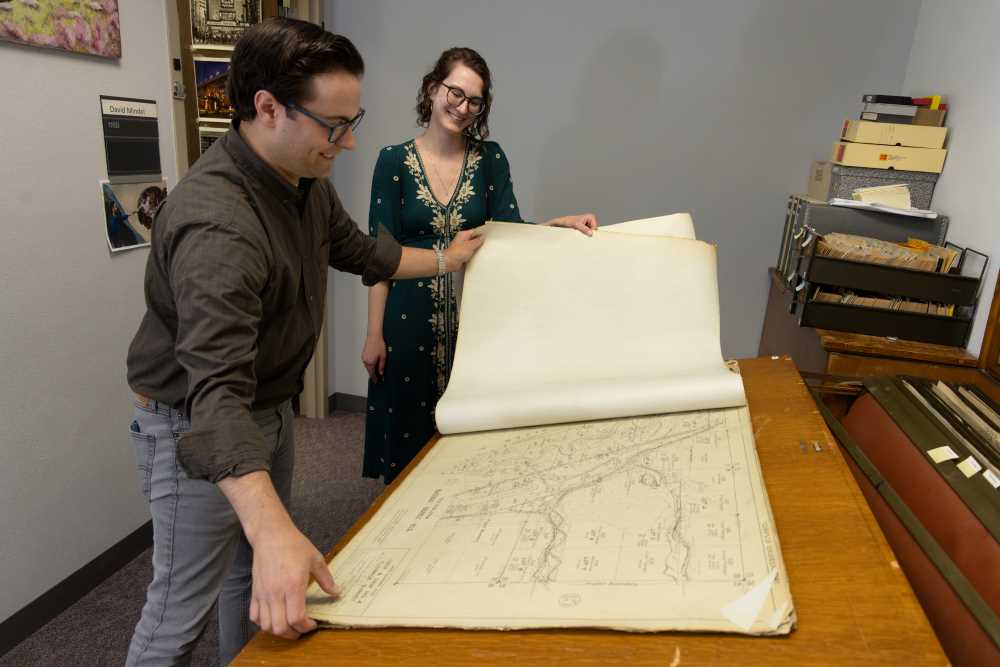
From left, David Mindel and Nikki Pegarsch look at charts from 1932 of locks and dams on Upper Mississippi River. Collections related to the Upper Mississippi River and Driftless Area have been growing organically on the UWL campus since the university’s inception.
New library initiative aims to expand access and grow collections related to Upper Mississippi River and Driftless Area
From steamboats to bird journals, river maps to agricultural research, UW-La Crosse has long been a repository for items related to the Upper Mississippi River and the Driftless Area of Wisconsin. Given its geographic location just over a mile from the river’s edge, the university has naturally attracted such collections, filling archival rooms.
Recently, library staff solidified their commitment to enhancing and growing this collection by launching The Driftless River Initiative. The initiative aims to bring together collectors and collections of materials related to the scientific, environmental, cultural, historical, and economic aspects of the Upper Mississippi River and Driftless Area. Managing these items in a central repository at UWL, where their long-term preservation can be guaranteed, will make them more visible and accessible to the general public for years to come. It will also make it possible to digitize items, expanding their reach globally online.
“Libraries and archives are in the unique position to offer perpetual preservation of and access to materials” says David Mindel, digital collections librarian. “By tying these materials together, not only are we breathing new life into collections that might otherwise be forgotten or lost, but we are guaranteeing their existence long into the future.”
Mindel also hopes awareness of the mounting collections will help inspire collaborations among researchers, including students, who can help draw more connections between the materials.
A historical legacy of river and driftless collections

Collections related to the Upper Mississippi River and Driftless Area have been growing organically since the university’s inception. Notably, in 1920, former La Crosse newspaper publisher turned politician, Ellis B. Usher, donated his private library — a collection of reference and historical works pertaining to the development of the Upper Mississippi Valley and Wisconsin — to the university. Usher’s gift was just the beginning, paving the way for many subsequent donations.
Over time, the collection increased steadily with a wide variety of related materials being acquired, housed, and preserved, particularly increasing over the last half century. The 1970s and 1980s were pivotal in producing one of the most well-known historical steamboat photograph collections in the country, now totaling roughly 50,000 images on site. Around the same time, the founding of the UWL River Studies Center in 1972, further solidified UWL’s connection to not only collecting but also actively producing academic materials related to the Upper Mississippi River.
Recent contributions and growth
In recent decades, the collection has grown substantially. Significant contributions include UCLA Professor Emeritus Stanley Trimble’s materials on the geomorphology and soil erosion of the Driftless Area, the late UWL emeritus professor Fred Lesher’s birding field journals, and the Upper Mississippi River Conservation Committee’s entire library. Additional contributions have come from the Winona District Office of the Upper Mississippi River National Wildlife and Fish Refuge, as well as collections from late steamboat historians Dave Thompson and Richard Egan, and the late Stafford Happ’s materials and field notes on soil erosion and sedimentation.
“It is magnetic,” Mindel notes. “Simply put, if a large collection is donated, it draws other similar materials to come in, too. In our case, creating the initiative is a way to highlight all of these collections, attract additional related items, and facilitate the seemingly limitless possibilities for collaborations, research, and exploration.”
Mindel is particularly excited about the interdisciplinary nature of the collections, which cover science, history, agriculture, recreation, economics, transportation and culture. He envisions students and researchers from various fields engaging with these historic materials, creating new knowledge, and fostering a deeper appreciation and understanding of their significance.
Digitizing for the future

In her office near a sunny window in Murphy Library, Nikki Pegarsch, library digitization assistant, sorts through the Dave Thompson Steamboat Collection. Checks, ticket stubs, letters, receipts, and even some Civil War-era paper money are being prepared for digitization. The entire collection came posthumously.
“It was, and still is, humbling to have received this,” says Mindel. “This is just another example of how one’s legacy can live on. Dave was a collector known across the steamboat world, and now his collection lives here and is now part of this initiative.”
Pieces like these help people understand the past and how they got to where they are today. They help society learn from past mistakes and provide fodder for future research endeavors, explains Mindel. The role of libraries and archivies is to facilitate preservation so the understanding can come decades or even hundreds of years later.
“In 100 years, you and I will no longer be here, but these materials and their legacies will,” says Mindel. “This is not just about us looking back. It is about looking forward.”
